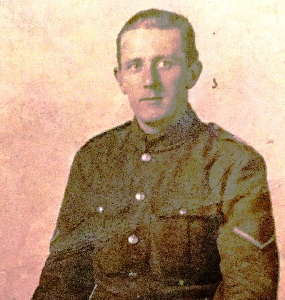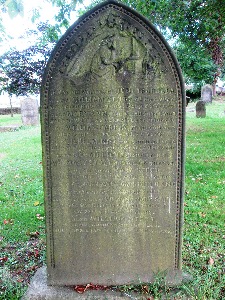
Photo: Richard Stott Grandson
Medal Index Card
Illustrated Chronicle 1915
RAMC at Hutton Terrace Drill Hall

Heworth Cemetery Headstone
Pauline Priano has submitted the following:-
John William Stott was born 1887 at South Shields, one of 4 children, one brother called Edward born 1892, who became a Blacksmith, one daughter called Mary, and 1 son deceased in infancy, born to William Stott of Leith, Midlothian Scotland, born 1850, died April 13th 1940, and Mary nee Riddle born 1861 at Jarrow, died June 15th 1917, who were married in the district of Gateshead in 1884. William was a cooper in the chemical trade in 1901.
The family in 1901 were residing at 8, Portland Street, Heworth, later moving to 25 Croxdale Terrace, Pelaw-on-Tyne. His youngest son Edward [Edmund], worked as an apprentice blacksmith whilst John William, now 23 years, was a law clerk, working for a firm of Solicitors, Swinburne Wilson. John William by then 1912, was residing at at 5 Wellfield Terrace, Bill Quay.
John William married on the 14th September 1912, to a Sarah Nixon Featherstone at Bill Quay Wesleyan Methodist Chapel. Sarah was born in Elton Street, Wallsend on the 27th October 1887, the daughter of John Thomas Featherstone who was a ship's carpenter. She was a school teacher. She died on the 22nd November 1969.
John and Sarah had two children, John Wilson Scott born on the 7th July 1914, an optician, born at Eldon Cottage, Coleridge Avenue, Low Fell, Gateshead, [in 1939, he was residing at 65 Hollywood Avenue, Gosforth, Northumberland, with his widowed mother, his brother Maurice who was a police Constable on probation], and Maurice William Stott born on the 7th August 1916 residing at 17 Dean Street Low Fell.
John William was originally in the Tyne Electrical Engineers with the service number 881, based at Tynemouth. He enlisted at North Shields in August 1914. In 1916, the Tyne Electrical Engineers had a re-organisation with some personnel being transferred elsewhere.
John William transferred as a private to the Royal Army Medical Corps, on the 7th August 1916 and was assigned to the 1st Northumbrian General Hospital.
The 1st Northumbrian Field Ambulance was located at Cambridge Hall in Newcastle-upon-Tyne, which was formerly the Headquarters of the Northern Division R.A.M.C. It was positioned between St James's Congregational Church and the Brady and Martin Chemical Works, now occupied by private apartments now. Today only the Church remains.
The 1st Northumbrian Field Ambulance RAMC derived it's origins from the bearer company of the late 2nd Volunteer Battalion the Northumberland Fusiliers, now the 5th Battalion. There was a school of Instruction nearby, the Royal Victoria Infirmary, The Military Hospital and the School of Medicine.
The equipment in 1914 consisted of 3 Ambulance Wagons, 1 General Service Wagon, 1 Water Cart, 1 Hospital Marquee, 1 Operating and 4 Bell Tents and medical and surgical accessories. In 1912 40 men were in the Special Reserve.
Field Ambulances: Marriage of Bearer Company and Brigade Field Hospital. 3 per Infantry Division, (1 per Brigade), 9 Medical Officers, 1 Quartermaster, and 224 Other Ranks. A, B, and C sections, each with bearer and tented elements. 10 Horse Drawn Ambulances.
John William was attached to the 77th Field Ambulance of the 25th Division and served on the Western Front from the 27th September 1915. The Field Ambulance was a mobile front line medical unit, not a vehicle, responsible for the care of casualties in its Division, establishing and operating a chain of evacuation for the casualties, from stretcher bearers to Advance Dressing Station and Main Dressing Stations and was never more than 600 yards behind the front line.
On the 27th May the unit was at Muscourt. The Germans were attacking from the left flank, meanwhile two squads were bringing in patients to evacuate. The Germans were machine gunning the evacuation route to Romain Village. Moved the ADS to Romain Village at about 8 pm. The Dressing Station had been machine gunned, patients then moved to the Casualty Clearing Station.
John William Stott was killed in the above action, on May 27th 1918, aged 31 years. His sacrifice is recorded as one of the 3,887 names of British servicemen with no known grave on the Soissons Memorial, Soissons, commemorating those who fell in the sector from May to August 1918 during the Spring Offensive, including the Third Battle of the Aisne and the Second Battle of the Marne.
His widow Sarah received all monies due to him, a pension and his awards of the British War Medal and Victory Medal, sent to her at 17, Dean Street, Low Fell, Gateshead, County Durham.
Acknowledgements: Richard Stott
John William Stott is remembered at Heworth on H92.03 in Gateshead on G39.004 page 93 and G39.064 and in Bill Quay on B119.01
Northern General Hospital photographs
RAMC Golden book
The CWGC entry for Private Stott

